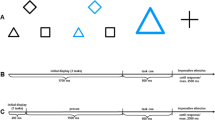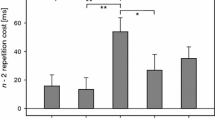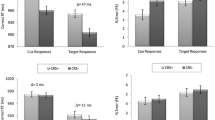Abstract
Switching between competing tasks is supported by active inhibition of the preceding task. The level of task stimulus processing at which interference between competing tasks must occur for inhibition to be recruited is still unclear. Here, we investigated whether inhibition is recruited by task conflict occurring at an early or late (semantic) stage of task stimulus processing by dissociating the task stimulus format from its meaning. In two experiments, participants performed three different numerical judgment tasks on numerical stimuli that could be presented as digits or number words (e.g., “6” or “six”) in a cued task-switching procedure. The effects of the change of stimulus format for the inhibition of the previous task were investigated and assessed by the N-2 task repetition cost, an index of the extent to which task representations are inhibited. The N-2 task repetition cost observed in the same stimulus format condition disappeared when target stimuli on task N-1 were presented in a different format from stimuli of task N-2 and N. This occurred both when the format changed from digits to number words stimuli (Experiment 1) as well as when it changed from number words to digits stimuli (Experiment 2). Results indicated that task set inhibition is recruited very early during the stimulus processing stage. They also provided evidence that task inhibition is not tied to task preparation processes but operates as a reactive, rather than proactive mechanism of conflict resolution.




Similar content being viewed by others
Availability of data and material
The datasets generated during the current study are available from the corresponding author on reasonable request.
References
Allport, D. A., Styles, E. A., & Hsieh, S. (1994). Shifting intentional set: Exploring the dynamic control of tasks. In C. Umilta & M. Moscovitch (Eds.), Attention and performance XV: Conscious and nonconscious information processing (pp. 421–452). MIT Press.
Arbuthnott, K., & Frank, J. (2000). Executive control in set switching: Residual switch cost and task-set inhibition. Canadian Journal of Experimental Psychology, 54(1), 33–41. https://doi.org/10.1037/h0087328
Arbuthnott, K., & Woodward, T. S. (2002). The influence of cue-task association and location on switch cost and alternating-switch cost. Canadian Journal of Experimental Psychology, 56, 18–29.
Aron, A. R. (2007). The neural basis of inhibition in cognitive control. The Neuroscientist, 13(3), 214–228. https://doi.org/10.1177/1073858407299288
Baddeley, A., Chincotta, D., & Adlam, A. (2001). Working memory and the control of action: Evidence from task switching. Journal of Experimental Psychology: General., 130, 641–657.
Corbetta, M., & Shulman, G. (2002). Control of goal-directed and stimulus-driven attention in the brain. Nature Reviews Neuroscience, 3, 201–215. https://doi.org/10.1038/nrn755
Emerson, M. J., & Miyake, A. (2003). The role of inner speech in task switching: A dual-task investigation. Journal of Memory and Language, 48, 148–168. https://doi.org/10.1016/S0749-596X(02)00511-9
Gade, M., & Koch, I. (2007). The influence of overlapping response sets on task inhibition. Memory & Cognition, 35, 603–609.
Gade, M., & Koch, I. (2014). Cue type affects preparatory influences on task inhibition. Acta Psychologica, 148, 12–18. https://doi.org/10.1016/j.actpsy.2013.12.009
Gade, M., Souza, A. S., Druey, M. D., & Oberauer, K. (2017). Analogous selection processes in declarative and procedural working memory: N-2 list-repetition and task-repetition costs. Memory & Cognition, 45(1), 26–39.
Goschke, T. (2000). Intentional reconfiguration and involuntary persistence in task set switching. In S. Monsell & J. Driver (Eds.), Control of cognitive processes: Attention and performance XVIII (pp. 331–355). MIT Press.
Grange, J. A., Kowalczyk, A. W., & O’Loughlin, R. (2017). The effect of episodic retrieval on inhibition in task switching. Journal of Experimental Psychology: Human Perception and Performance, 43, 1568–1583.
Houghton, G., Pritchard, R., & Grange, J. A. (2009). The role of cue-target translation in backward inhibition of attentional set. Journal of Experimental Psychology: Learning, Memory, and Cognition, 35, 466–476. https://doi.org/10.1037/a0014648
Hübner, M., Dreisbach, G., Haider, H., & Kluwe, R. H. (2003). Backward inhibition as a means of sequential task-set control: Evidence for reduction of task competition. Journal of Experimental Psychology: Learning, Memory, & Cognition, 29, 289–297.
Kiesel, A., Steinhauser, M., Wendt, M., Falkenstein, M., Jost, K., Philipp, A. M., & Koch, I. (2010). Control and interference in task switching—A review. Psychological Bulletin, 136, 849–874. https://doi.org/10.1037/a0019842
Koch, I., Gade, M., Schuch, S., & Philipp, A. M. (2010). The role of inhibition in task switching: A review. Psychonomic Bulletin & Review, 17, 1–14. https://doi.org/10.3758/PBR.17.1.1
Koch, I., Poljac, E., Müller, H., & Kiesel, A. (2018). Cognitive structure, flexibility, and plasticity in human multitasking—An integrative review of dual-task and task-switching research. Psychological Bulletin, 144(6), 557–583. https://doi.org/10.1037/bul0000144
Liston, C., Malaton, S., Hare, T. A., Davidson, M. C., & Casey, B. J. (2006). Anterior cingulate and posterior parietal cortices are sensitive to dissociable forms of conflict in a task-switching paradigm. Neuron, 50, 643–653. https://doi.org/10.1016/j.neuron.2006.04.015
Logan, G. D. (1994). On the ability to inhibit thought and action: A users’ guide to the stop signal paradigm. In D. Dagenbach & T. H. Carr (Eds.), Inhibitory processes in attention, memory, and language (pp. 189–239). Academic Press.
Mayr, U., & Keele, S. W. (2000). Changing internal constraints on action: The role of backward inhibition. Journal of Experimental Psychology: General, 129, 4–26.
Monsell, S. (2003). Task switching. Trends in Cognitive Sciences, 7, 134–140.
Morey, R. D. (2008). Confidence intervals from normalized data: A correction to Cousineau (2005). Tutorial in Quantitative Methods for Psychology, 4, 61–64.
Oberauer, K. (2009). Design for a working memory. Psychology of Learning and Motivation, 51, 45–100. https://doi.org/10.1016/S0079-7421(09)51002-X
Philipp, A. M., Jolicoeur, P., Falkenstein, M., & Koch, I. (2007). Response selection and response execution in task switching: Evidence from a go-signal paradigm. Journal of Experimental Psychology: Learning, Memory, and Cognition, 33, 1062–1075. https://doi.org/10.1037/0278-7393.33.6.1062
Philipp, A. M., & Koch, I. (2006). Task inhibition and task repetition in task switching. European Journal of Cognitive Psychology, 18, 624–639. https://doi.org/10.1080/09541440500423269
Prosser, L. J., Jackson, M. C., & Swainson, R. (2020). Task cues lead to item-level backward inhibition with univalent stimuli and responses. Quarterly Journal of Experimental Psychology., 73, 442–457. https://doi.org/10.1177/1747021819882901
Rogers, R. D., & Monsell, S. (1995). Costs of a predictable switch between simple cognitive tasks. Journal of Experimental Psychology: General, 124, 207–231.
Sakai, K. (2008). Task set and prefrontal cortex. Annual Review of Neuroscience, 31, 219–245. https://doi.org/10.1146/annurev.neuro.31.060407.125642
Scheil, J., & Kleinsorge, T. (2014). Tracing the time course of n - 2 repetition costs in task switching. Experimental Brain Research, 232, 3535–3544. https://doi.org/10.1007/s00221-014-4044-4
Scheil, J., & Kleinsorge, T. (2019). Effects of global and local task repetition proportion on n−2 repetition costs. The Quarterly Journal of Experimental Psychology, 72, 579–588. https://doi.org/10.1177/1747021818762087
Schuch, S., & Koch, I. (2003). The role of response selection for inhibition of task sets in task shifting. Journal of Experimental Psychology: Human Perception & Performance, 29, 92–105.
Sdoia, S., & Ferlazzo, F. (2008). Stimulus-related inhibition of task set during task switching. Experimental Psychology, 55, 322–327.
Sdoia, S., Zivi, P., & Ferlazzo, F. (2020). Anodal tDCS over the right parietal but not frontal cortex enhances the ability to overcome task set inhibition during task switching. PLoS ONE, 15(2), e0228541. https://doi.org/10.1371/journal.pone.0228541
Sexton, N. J., & Cooper, R. P. (2017). Task inhibition, conflict, and the n-2 repetition cost: A combined computational and empirical approach. Cognitive Psychology, 94, 1–25.
Storey, J. D., Taylor, J. E., & Siegmund, D. (2004). Strong control, conservative point estimation and simultaneous conservative consistency of false discovery rates: A unified approach. Journal of the Royal Statistical Society B, 66, 187–205.
Storey, J. D., & Tibshirani, R. (2003). Statistical significance for genome-wide studies. Proceedings of the National Academy of Science u.s.a., 100, 9440–9445.
Tipper, S. P. (2001). Does negative priming reflect inhibitory mechanisms? A review and integration of conflicting views. The Quarterly Journal of Experimental Psychology, 54A, 321–343. https://doi.org/10.1080/14640748508400921
Vandierendonck, A., Liefooghe, B., & Verbruggen, F. (2010). Task switching: Interplay of reconfiguration and interference control. Psychological Bulletin, 136(4), 601–626. https://doi.org/10.1037/a0019791
Zhang, R., Stock, A. K., Fischer, R., & Beste, C. (2016). The system neurophysiological basis of backward inhibition. Brain Structure and Function., 221, 4575–4587. https://doi.org/10.1007/s00429-016-1186-0
Funding
This study was supported by a grant from the Sapienza University of Rome to SS (RM1181643660189A).
Author information
Authors and Affiliations
Contributions
All authors contributed to the study conception and design. Material preparation, data collection and analysis were performed by PZ. The first draft of the manuscript was written by PZ and SS and all authors commented on previous versions of the manuscript. All authors read and approved the final manuscript.
Corresponding author
Ethics declarations
Conflict of interest
Authors declare no competing interests.
Ethics approval
The study was approved by the Institutional Review Board of the Department of Psychology of Sapienza University of Rome, Italy, prot. n. 0001289, 07/12/2017 and conducted in accordance with the 1964 Helsinki declaration and its later amendments. The manuscript does not report clinical studies or patient data.
Consent to participate
Each participant included in the study gave informed consent to participate.
Additional information
Publisher's Note
Springer Nature remains neutral with regard to jurisdictional claims in published maps and institutional affiliations.
Rights and permissions
About this article
Cite this article
Sdoia, S., Zivi, P. & Ferlazzo, F. The impact of stimulus format on task inhibition during task switching. Psychological Research 86, 2185–2194 (2022). https://doi.org/10.1007/s00426-021-01634-y
Received:
Accepted:
Published:
Issue Date:
DOI: https://doi.org/10.1007/s00426-021-01634-y




